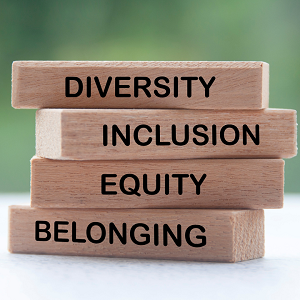
Assembling a workforce that reflects different ages, ethnicities, abilities, genders, and cultural backgrounds adds value to conversations; challenges the way people think; and enhances employee morale, recruitment, and retention. It also increases profitability.1 Yet doing this is not easy. Work to ensure diversity, equity, inclusion, belonging, and accessibility (DEIBA) in workplaces is fraught with challenges and “multiple hurdles to success,” as one author notes.2 And it may get even harder after the U.S. Supreme Court decision on affirmative action3 in college and university admissions.
Some legal experts4 say the court’s decision to strike down race-conscious admissions will not have an immediate effect on employers because it did not include Title VII of the Civil Rights Act of 1964, which governs private workplaces. Yet others believe the decision will erode positive strides made in hiring practices.5 Recent headlines focus on race, but DEIBA represents a larger umbrella that includes people with disabilities. While data6 shows a drop in unemployment among people with disabilities, which is currently at 7.3%, that rate is high compared with 3.7% for the general public. And unconscious bias for this group is higher than unconscious bias based on gender or race.7
Unconscious Bias
The issue of unconscious bias hits a nerve with benefit professionals, who understand the risks associated with policies that benefit some but not all employees. Consider the change from maternity leave to parental leave. It is a best practice to review policies on an annual basis to ensure policies are written clearly and equitably, and to identify those at the end of their shelf life.
For example, employers have been advised to describe paid parental leave as bonding time that is separate from a medical condition associated with pregnancy-related disability. Failure to do this could lead to what a speaker at the 2023 DMEC FMLA/ADA Employer Compliance Conference called “radioactive risk,” when employees question differences in paid time off. Changes to policies should be communicated regularly to ensure employees understand differences in time off by leave type. And if you haven’t already done so, remove “primary” and “secondary” caregiver language from parental leave policies to avoid gender discrimination.8
Using a DEIBA lens helps employers identify preferential policies and adjust course. It can also help employers add benefits to attract and retain people with different needs, such as elder care and caregiver leaves. Other work includes editing employer forms that only have binary gender options to acknowledge broader gender definitions. And as the definition of a family member expands in paid family medical leave laws, employers are reassessing company leaves to ensure they remain inclusive as well as competitive.9
While some of this work was prompted by recent state laws,9 employers have invested in inclusion efforts for many years as illustrated by the @Work magazine article about PG&E employee resource groups started in the ‘70s.10
DEIBA efforts are valuable to employers on several levels,11 especially given that Gen Z is the most diverse generation to date. The generation comprises 30% of the world’s population and is expected to account for 27% of the workforce by 2025.12,13
Using program utilization data and employee surveys can inform and guide DEIBA programs, and help determine whether employees benefit equally from policies. One 2023 DMEC Compliance Conference attendee shared her team’s work to revamp policy language after learning from an employee survey that some employees of color did not believe the leave was intended for them.
Investments
In addition to spending billions of dollars14 annually on DEIBA training, employers are encouraged to take a long-term view with this work. However, market indicators show a softening related to DEIBA-related hiring. While diversity officer titles were among the top four C-suite roles hired in 2020 and 2021, a report15 showed a decline in 2022 with “waning corporate interest in diversity programs and higher levels of turnover for diversity roles ….” Articles cite increasing burnout among diversity experts, who worry about lofty promises made with little follow-through.
To avoid these pitfalls, employers should define DEIBA within their organizations, set reasonable expectations for progress, identify metrics for success, and create a timeline to show employees when they can expect to see changes (and hear updates).16 It is also helpful to consider models of success, such as Bill Darden. He opened the first Darden’s Restaurant in 1938 (at the age of 19) and employed anyone who was willing to work hard “without regard to race, gender, or background,” explained Melissa Kirkland, leave administration manager, during the 2023 DMEC Compliance Conference. Eighty-five years later, the Darden Restaurants Inc. team works with more than 6,000 community groups to share job listings and ensure a pipeline of diverse leaders. As a result, 64% of its executive leadership includes people from different racial and ethnic backgrounds. And that matters with absence and disability policies and programs.
“What may work for one may not always work for another,” said Kirkland, who emphasized the need for open communication to understand employees’ needs for leave. “A millennial may heal in a different manner and speed than a Gen Xer, and an African American diabetic may heal in a different manner than a healthy Caucasian.”
Pressure on All Sides
While questions swirl about how workplace DEIBA efforts will be affected by the Supreme Court decision, there is mounting pressure for employers to prove their culture and business practices reflect DEIB tenets. The Equal Employment Opportunity Commission requires employers with more than 100 employees as well as federal contractors that have at least 50 employees to file annual Employment Information17 reports, which highlight racial and ethnic demographics. And there is increasing demand for companies to release the reports publicly.18
We do not know how the Supreme Court decision will affect private employers. What we do know is that building a company culture that attracts the best and brightest requires leaders to embrace change and acknowledge and celebrate differences. While laws (and interpretation of them) may change, values that attract people to jobs and influence buying decisions do not.
During times of uncertainty, employers should stay the course with work that helps recruit and retain employees, and build cultures that create a sense of belonging for all employees.
References
- Gartner. Diversity and Inclusion Build High-Performance Teams. Sept. 20, 2019. Retrieved from https://www.gartner.com/smarterwithgartner/diversity-and-inclusion-build-high-performance-teams
- AXIOS. The Chief Diversity Officer Hiring Frenzy. May 20, 2021. Retrieved from https://www.axios.com/2021/05/20/chief-diversity-officer-hiring-frenzy
- Supreme Court of the United States. Students for Fair Admissions, Inc. v. President and Fellows of Harvard College. June 29, 2023. Retrieved from https://www.supremecourt.gov/opinions/22pdf/20-1199_hgdj.pdf
- Catalyst. Does the US Supreme Court Decision on Affirmative Action Affect Your Company’s Diversity Initiatives? June 29, 2023. Retrieved from https://www.catalyst.org/2023/06/29/legal-experts-supremecourt-affirmative-action/
- Employer Benefit News. How the Supreme Court’s Decision on Affirmative Action Will Impact Employers. June 29, 2023. Retrieved from https://www.benefitnews.com/news/supreme-courts-ruling-on-affirmative-action-and-dei
- U.S. Bureau of Labor Statistics. Employment Status of the Civilian Population by Sex, Age, and Disability Status, Not Seasonally Adjusted. July 7, 2023. Retrieved from https://www.bls.gov/news.release/empsit.t06.htm
- The Harvard Gazette. Why Disability Bias is a Particularly Stubborn Problem. Jan. 10, 2022. Retrieved from https://news.harvard.edu/gazette/story/2022/01/why-disability-bias-is-a-particularly-stubborn-problem/
- DMEC. To Gender Equity and Beyond. March 20, 2023. Retrieved from http://dmec.org/2023/03/20/to-gender-equality-and-beyond/
- DMEC. State and Local Leave Laws Resource. Retrieved from http://dmec.org/resources/state-and-local-leave-laws-resource/
- DMEC. ERGs Help Break Down Mental Health Stigma by Engaging and Supporting Employees. Aug. 24, 2022. Retrieved from http://dmec.org/2022/08/24/ergs-help-break-down-mental-health-stigma-by-engaging-and-supporting-employees/
- DMEC. Creating Cultures of Inclusivity and Belonging podcast episode. Retrieved from https://player.captivate.fm/episode/4e7d2107-a2fe-488a-a8e7-514d9245cb29
- Pew Research Center. On the Cusp of Adulthood and Facing an Uncertain Future: What We Know About Gen Z So Far. May 14, 2020. Retrieved from https://www.pewresearch.org/social-trends/2020/05/14/on-the-cusp-of-adulthood-and-facing-an-uncertain-future-what-we-kUnow-about-gen-z-so-far-2/
- Forbes. The Future of Work Depends on Supporting Gen Z. July 22, 2022. Retrieved from https://www.forbes.com/sites/onemind/2022/07/22/the-future-of-work-depends-on-supporting-gen-z/?sh=67d30c46447a
- Harvard Business Review. Data-Driven Diversity. March-April 2022. Retrieved from https://hbr.org/2022/03/data-driven-diversity
- LinkedIn. Who’s Vaulting into the C-Suite? Trends Changed Fast in 2022. Feb. 1, 2023. Retrieved from https://www.linkedin.com/pulse/whos-vaulting-c-suite-trends-changed-fast-2022-george-anders/?trackingId=jOiiEvmfQI6sMbG%2BKwpCIQ%3D%3D
- DMEC. Encourage Employees to be Fearlessly Authentic. Feb. 9, 2023. Retrieved from https://player.captivate.fm/episode/30b9da33-f66b-446b-96c9-20fca81a5a61
- Equal Employment Opportunity Commission. Legal Requirements. Retrieved from https://www.dol.gov/agencies/ofccp/faqs/eeo1-report
- Fortune. These Companies are Following Through on Their Promises on Diversity, Equity, and Inclusion. Jan. 17, 2022. Retrieved from https://fortune.com/2022/01/17/diversity-pledges-ceo-action-social-justice/











